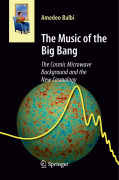
Astronomers' universe: the music of the Big Bang : the cosmic microwave background and the new cosmology
Balbi, A.
The cosmic microwave background radiation is the afterglow of the big bang: atenuous signal, more than 13 billion years old, which carries the answers to many of the questions about the nature of our Universe. It was serendipitouslydiscovered in 1964, and thoroughly investigated in the last four decades by alarge number of experiments. Two Nobel Prizes in Physics have already been awarded for research on the cosmic background radiation: one in 1978 to Arno Penzias and Robert Wilson, who first discovered it, the other in 2006, to George Smoot and John Mather, for the results of the COBE satellite. Most cosmological information is encoded in the cosmic background radiation by acoustic oscillations in the dense plasma that filled the primordial Universe: a "music" of the big bang, which cosmologists have long been trying to reconstruct and analyze, in order to distinguish different cosmological models, much like one can distinguish different musical instruments by their timbre and overtones. Explains, in simple terms, the discovery and significance of the cosmic background radiation Makes this vital window onto the early universe accessible to generalreaders INDICE: Prologue.- The framework (an introduction to the Big Bang model).-First light (an introduction to the cosmic background radiation - CMB).- Cosmic seeds (structure formation in the Universe and the CMB).- Music of the spheres (acoustic oscillations in the primordial Universe).- Finding harmony (the discovery of acoustic oscillations in the CMB power spectrum).- The undiscovered country (some future prospects).- Epilogue.
- ISBN: 978-3-540-78726-6
- Editorial: Springer
- Encuadernacion: Cartoné
- Páginas: 230
- Fecha Publicación: 01/07/2008
- Nº Volúmenes: 1
- Idioma: Inglés
